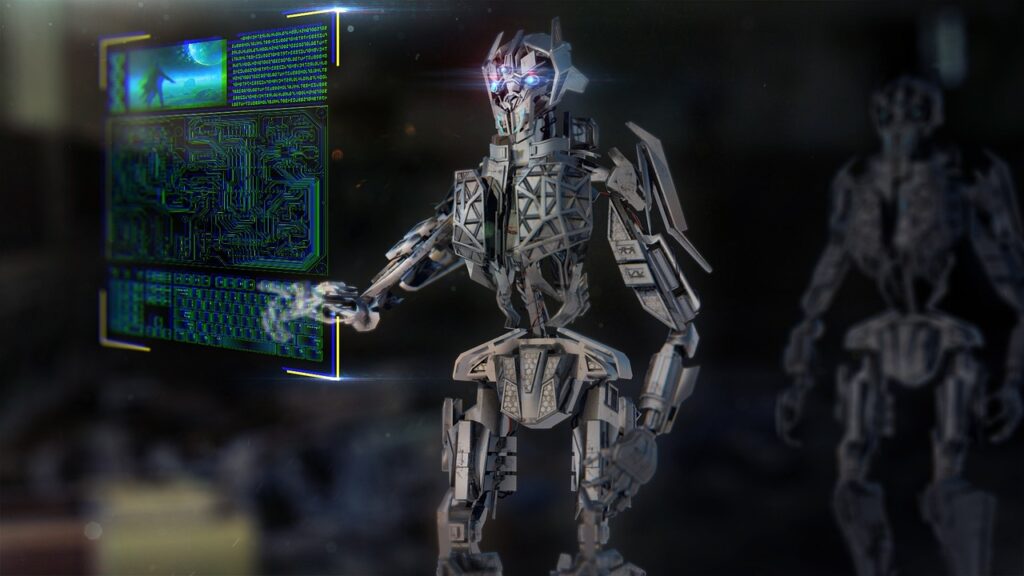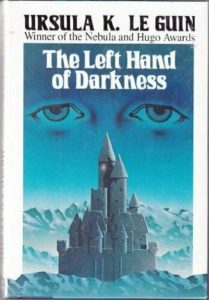Most popular articles for January 2024:
Science fiction and world-building go hand-in-hand. You can’t have one without the other.
When you write a sci-story or novel, you’re creating a time and place that doesn’t currently exist. And that time and place should have its own unique set of rules, cultures and norms. That’s world-building!
But how do you achieve these things when writing a science fiction story or novel? How do you build a unique and interesting world for your characters? How do you bring it to life?
Most importantly, how do you make it feel real?
Before we get to the “how” we have to address the “what.” So here’s a definition of world-building as it relates to the art and craft of science fiction.
What Is World-Building, Exactly?
World-building is the process of creating a fictional world or setting that’s believable, consistent, and engaging. To achieve this, writers have to consider the physical, social, and cultural aspects of the world in which their story unfolds.

But don’t be intimidated by this loftiness. You can create an effective story with even a limited amount of world-building. In science fiction, world-building can occur on a grand scale, as in Frank Herbert’s expansive Dune—or on a smaller scale, like a single moment in time.
You get to decide how much of a “world” you want to create and portray.
When done well, science fiction world-building gives the reader a more immersive experience. It allows them to “get lost” in the story. Well-built worlds can also lend credibility to a sci-fi story, helping the reader suspend disbelief and accept what is happening on the page.
Suspension of disbelief is important for all fiction genres. When you think about it, fiction is basically a lie you want people to view as a truth. You’re making up a story and inviting readers to experience it on an emotional level, as if it’s really happening.
Suspension of disbelief is even more important for science fiction stories.
Sci-fi writers build stories around things that don’t currently exist and might be hard for readers to accept. To bridge this gap, science fiction writers must create authentic, detailed, and internally consistent worlds to house their stories.
So let’s look at some of the steps and strategies needed to accomplish this.
Step 1: Map Out the Time and Place
When and where does the story take place? What is the nature of that time and place? When and where do the major events unfold? These are some of the first considerations you’ll encounter when planning your story and building your world.
A couple of tips to help you pin this down:
Create a timeline.
Your sci-fi story might take place in the near future in a world we recognize, or in some faraway setting that has nothing to do with our own. Either way, you need to establish a relative timeline to keep track of the history and current events that unfold in your story.
You need to keep it all straight—in your head and on the page. And the best way to do that is also the easiest. Just draw it out on paper, revising the timeline as needed as your story progresses.
Draw a map.
Once you get all of the “when” details ironed out, you need to address the “where.” Think about the location and geography of your story setting.
Does it take place in a world the reader would recognize, perhaps in the near future? Or does the story take us into completely new and unfamiliar territory?
And don’t worry, you don’t have to learn cartography to complete this step. Just sketch out a basic map to orient yourself and the story. This will help you maintain consistency and avoid losing the reader.
The amount of work involved here will depend on the scale and scope of your science fiction story. The more expansive the story, the more mapping and timelining you’ll have to do. Small-scale science fiction, on the other hand, requires much less forethought and planning.
Step 2: Develop and Respect the Rules
Science fiction world-building requires strict rules and parameters. Again, it comes down to consistency. If the laws of your fictional world change from one chapter to the next, you’ll only end up confusing the reader.
If the rules change for some scientifically valid reason—and the reader understands what those reasons are—you’re good to go. But if you change things on a whim, with no explanation given, your fictional world begins to fall apart.
The sci-fi world you create should follow its own set of rules and principles. Whether it’s the laws of physics, biology, or societal norms, consistency is key. Try to avoid introducing elements that contradict the established rules, unless you have a well-thought-out explanation.
If you introduce advanced technology or futuristic physics in one chapter, make sure all subsequent chapters remain consistent. If your story involves faster-than-light travel, it has to “work” the same throughout the story. The technology needs clear rules and consequences.
Here are some more examples of internal consistency:
- Artificial Intelligence: If you have highly advanced AI in your world, establish clear rules for their capabilities and limitations. Are there ethical constraints on their actions? How do they interact with humans, and what are their goals?
- Time Travel: If time travel is a part of your world, establish a coherent system for how it works. Are there fixed timelines? Parallel universes? Alternate dimensions? Avoid creating paradoxes that could disrupt the narrative’s logic and confuse readers. Keep it consistent and plausible.
- Space Travel: Define the physics and mechanics of space travel. How do spaceships achieve propulsion and maneuverability? What are the challenges and limitations of traveling through space, such as fuel constraints or radiation exposure?
- Economics: If your world has a different economic system, define how it functions and its impact on society. Is it based on a different form of currency, trade or resources? Ensure that trade and commerce remain consistent with this system.
- Social Hierarchies: Establish the hierarchies and power structures within societies. Who holds political power, and how is it maintained? How do these hierarchies affect the lives of ordinary citizens and the distribution of resources?
Step 3: Highlight Everyday Details
When building a unique world in your science fiction story, try to balance the big-picture components with smaller, everyday details.
- The big picture includes things like culture, religion and geography.
- The smaller details include clothing, food, slang, music, jobs, etc.
What kinds of foods do your characters eat? What kinds of advanced (from our perspective) tools do they use in their everyday lives? What do they wear for their jobs, and why?
Details are a key part of science fiction world-building. They can help you create a fictional world that somehow feels lived in. They help readers connect with and understand your story world, even if it’s futuristic or alien in nature.
Step 4: Create Believable Societies (or Not)
If your story takes place on Earth, or in a time and place the reader will recognize, you can probably skip this step. But if it involves fictional cultures and societies, you’ll need to work out the details and make sure the reader understands them.
Consider the difference in these two science fiction novels:
The Left Hand of Darkness, by Ursula K. Le Guin
Most of this story takes place on a planet called Gethen. The planet’s inhabitants are ambisexual, meaning they can change their sexual characteristics, becoming both male and female at different times.

Le Guin not only created a fictional planet and culture. She also gave the inhabitants a unique biological ability that’s completely foreign to us as humans.
But she does a great job describing Gethen and its alien race, so readers can suspend their disbelief. We can see the world in our mind’s eye.
Throughout the novel, we encounter detailed and authentic descriptions like the example below, which describes the ancient city of Rer:
All the buildings of Rer are fantastically massive, deep-founded, weatherproof and waterproof. In winter the wind of the plains may keep the city clear of snow, but when it blizzards and piles up they do not clear the streets, having no streets to clear. They use the stone tunnels, or burrow temporary ones in the snow. Nothing of the houses but the roof sticks out above the snow, and the winter-doors may be set under the eaves or in the roof itself, like dormers.
The Martian, by Andy Weir
This novel does not create entirely new cultures or societies. Instead, the story takes place in the near-future and primarily on the planet Mars.

While it introduces advanced technology and the challenges of surviving on Mars, the cultural and societal norms remain largely consistent with our current understanding of human society.
They’re both science fiction novels, but they differ a lot when it comes to world-building. One story imagines a whole new race of beings, while the other depicts survival on a known planet.
But they both achieve believability by using detail and consistency. In doing so, they allow the reader to become immersed and live within the story.
Step 5. Balance the Science and the Story
Science fiction stories cover a broad spectrum when it comes to the amount of science they contain. Some use a vague scientific backdrop to tell a human story, while others focus more heavily on the scientific or technical aspects (i.e., “hard” science fiction).
Other stories strike a balance somewhere in between.
Ultimately, however, you have to remember that you’re writing a story—not a textbook. Stories are engaging, immersive and often exciting. Textbooks are purely educational. But both require thorough research.
When building a world for your science fiction story, you’ll eventually need to conduct research. This is one of the things that sets sci-fi stories apart from other genres. It tends to require more research. With the possible exception of historical fiction, I can think of no other genre that requires as much research as sci-fi.
We touched on the reasons for this already. If you want readers to suspend their disbelief and become immersed in your story, you have to create an authentic world with consistent rules and plausible science. And that requires research.
An Example From My Own Experience
I once spent hours researching the materials that might be used to create the eyes of a synthetic android in the not-too-distant future. Why? Because I was writing a book about rogue, murderous androids, and I wanted it to seem realistic. I needed to understand the science.
I don’t say this to boast. It’s not like I was going above and beyond the call of duty. This kind of research represents the bare minimum for science fiction writers.
The point is, you want to write from a place of knowledge. This is especially true when it comes to science fiction world-building. Details matter. Consistency and plausibility matter. And the only way to get there is through careful research.
But at the same time, you have to remember you’re telling a story. You’re entertaining people, fueling their escapism by delivering an interesting, exciting, and possibly thought-provoking tale.
When it comes to science fiction, world-building can enhance a story—or slow it to a crawl. The difference is in the delivery.
- The best-case scenario is to describe your fictional world little by little, as the characters move through it in their daily lives. Let the reader become acquainted with it gradually, one interesting detail at a time.
- The worst-case scenario is the dreaded info dump, where the writer pauses the story to convey a lot of information at one time in textbook fashion.

In the movie Aliens, we learn about the mining colony and terraforming efforts on the exomoon LV-426 in piecemeal fashion. As the story progresses, new details emerge, giving us a better sense of the dangerous world these characters are entering.
In Frank Herbert’s novel Dune, we learn about the complex world of Arrakis, its intricate politics, and the infamous sandworms. But these details are gradually woven into the narrative, allowing readers to learn as they go. We don’t get hit with it all at once.
Science fiction has two sides—and they’re both right there in the label. You need the science and technology, because that’s the nature of the genre. But you also need the components of good fiction, things like drama and tension, conflict and character development.
Get on the list! Want to learn more about science fiction world-building and other aspects of the genre? Subscribe to the Science Fiction Academy. You’ll get weekly tips on the craft, along with the ability to join discussion threads. See the link at the top of this page.